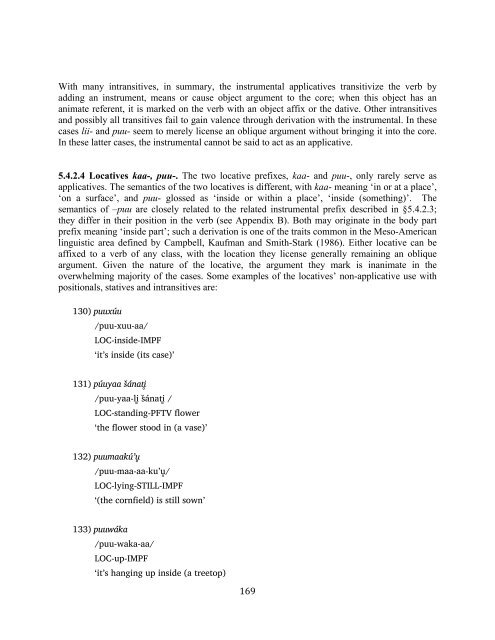The phonology and morphology of Filomeno Mata Totonac
The phonology and morphology of Filomeno Mata Totonac
The phonology and morphology of Filomeno Mata Totonac
Create successful ePaper yourself
Turn your PDF publications into a flip-book with our unique Google optimized e-Paper software.
With many intransitives, in summary, the instrumental applicatives transitivize the verb by<br />
adding an instrument, means or cause object argument to the core; when this object has an<br />
animate referent, it is marked on the verb with an object affix or the dative. Other intransitives<br />
<strong>and</strong> possibly all transitives fail to gain valence through derivation with the instrumental. In these<br />
cases lii- <strong>and</strong> puu- seem to merely license an oblique argument without bringing it into the core.<br />
In these latter cases, the instrumental cannot be said to act as an applicative.<br />
5.4.2.4 Locatives kaa-, puu-. <strong>The</strong> two locative prefixes, kaa- <strong>and</strong> puu-, only rarely serve as<br />
applicatives. <strong>The</strong> semantics <strong>of</strong> the two locatives is different, with kaa- meaning ‘in or at a place’,<br />
‘on a surface’, <strong>and</strong> puu- glossed as ‘inside or within a place’, ‘inside (something)’. <strong>The</strong><br />
semantics <strong>of</strong> –puu are closely related to the related instrumental prefix described in §5.4.2.3;<br />
they differ in their position in the verb (see Appendix B). Both may originate in the body part<br />
prefix meaning ‘inside part’; such a derivation is one <strong>of</strong> the traits common in the Meso-American<br />
linguistic area defined by Campbell, Kaufman <strong>and</strong> Smith-Stark (1986). Either locative can be<br />
affixed to a verb <strong>of</strong> any class, with the location they license generally remaining an oblique<br />
argument. Given the nature <strong>of</strong> the locative, the argument they mark is inanimate in the<br />
overwhelming majority <strong>of</strong> the cases. Some examples <strong>of</strong> the locatives’ non-applicative use with<br />
positionals, statives <strong>and</strong> intransitives are:<br />
130) puuxúu<br />
/puu-xuu-aa/<br />
LOC-inside-IMPF<br />
‘it’s inside (its case)’<br />
131) púuyaa s%ánati&<br />
/puu-yaa-li& s"ánati& /<br />
LOC-st<strong>and</strong>ing-PFTV flower<br />
‘the flower stood in (a vase)’<br />
132) puumaakú*u&<br />
/puu-maa-aa-ku’u&/<br />
LOC-lying-STILL-IMPF<br />
‘(the cornfield) is still sown’<br />
133) puuwáka<br />
/puu-waka-aa/<br />
LOC-up-IMPF<br />
‘it’s hanging up inside (a treetop)<br />
! "*-!

















